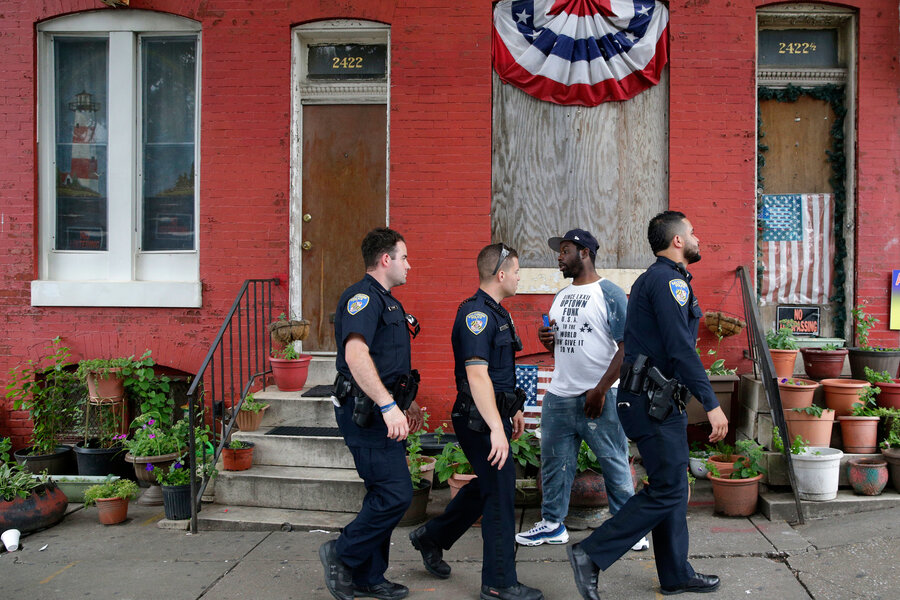Baltimore Police Department revamps 'use of force' policies: Is it enough?
Loading...
The Baltimore Police Department plans to institute a new use-of-force policy Friday which underscores the "sanctity of life" and emphasizes the de-escalation of conflicts, joining a national effort to offer more clarity and accountability around the often-fraught relations between police officers and community members.
Observers describe the new policy, which requires officers to intervene if they see another officer using excessive force, as "a good step forward." However, they suggest more could be done to provide officers with explicit guidance on how to handle a "dynamic encounter."
The last policy overhaul in 2003 included very little guidance on the use of force, according to the Associated Press, and precedes the release of a Justice Department investigation into the Baltimore Police Department following the death of Freddie Gray.
One of the new policies that goes into effect July 1 explicitly relates to the now-infamous death of Mr. Gray who died as a result of a broken neck likely sustained during police transit after arrest: Baltimore police must immediately render aid if someone in custody complains of an injury. Officers failed to respond Mr. Gray's repeated requests to be taken to a hospital, and he later died as a result of the injuries sustained while in police custody, in one of the flash point cases of young black men who have been killed while in police custody.
Eyes have been on Baltimore since Gray's death sparked a series of protests and violent clashes between the community and the police in April 2015, adding further fuel to the Black Lives Matter movement that has swept the country in the wake of the high-profile deaths of Eric Garner in New York, Michael Brown in Missouri, and Walter Scott in North Carolina. The trials of six Baltimore police officers in relation to his death, the first three of which have yielded no convictions, have left some activists wondering if any change in police accountability is possible. Other cities struggling with similar issues will likely be watching how this new policy affects police behavior and community relations as they search for their own paths forward.
"This is a good step forward, but it's still not specific enough," says William Terrill, who teaches in the School of Criminology and Criminal Justice at Arizona State University, in a phone interview with The Christian Science Monitor.
The new regulations expand the police uses of force that necessitate reporting to include, among other things, pointing a gun at a suspect. Every use of force will be entered into a "tracking database," Police Commissioner Kevin Davis announced Wednesday, according to The Baltimore Sun. Officers are required to attempt to de-escalate potentially violent situations through verbal persuasion and warnings whenever possible.
The policies, however, should have specifically laid out appropriate officer responses to specific types of citizen resistance, Dr. Terrill says.
"There's a lot in here about supervisory duties, but for the everyday cop on the street that wants to get it right, that wants to use the proportional, appropriate force, there's not a lot in here to offer them guidance to think through a dynamic encounter."
Though buzzwords like "de-escalation" and "proportionality" are missing elaboration, Terrill noted Baltimore's decision to lower the threshold for the reportable use of force was a positive change. Many police departments were hesitant to make the change, however, since it would increase the number of reported incidents, making it appear that more force is used over the coming year.
"In order for the policing profession to have a legitimate relationship with the people it serves, will require a dramatic change in how we capture, document, investigate, review and hold ourselves accountable – to our superiors and to our communities," argue Police Chief Charles Gruber and Wayne Schmidt, Esq. in Americans for Effective Law Enforcement law journal, noting that a public review of the use of force will begin a process of openness, building trust between police and communities.
A 2014 Pew Research poll found that 41 percent of whites believed police did a good or fair job using the right amount of force for a given situation, while only 6 percent of blacks said the same.
Police departments from New York to San Francisco are implementing new guidelines and tracking systems for using and documenting force. In October, New York made it mandatory for every instance of force, made not only during an arrest but during any interaction with the public, to be documented, so that the data can be analyzed for patterns.
In December, San Francisco Police Chief Greg Suhr clarified that pointing a service weapon at someone amounts to a use of force that officers must justify.
At a training on "diffuse and de-escalate" techniques” Tuesday, San Francisco police told NBC that the old imperative of keeping themselves, their fellow officers and the public safe, has been replaced with the goal of keeping everyone, including the suspect, safe whenever possible.
"Some policies are better at reducing injuries, other policies are better at improving public perception," Terrill tells the Monitor. "You can't come up with a universal policy so usually it's about making incremental changes and constantly assessing them, ideally, every one to two years."








